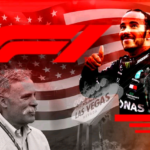The setting is the Indianapolis Motor Speedway: home to the world-famous Indy 500 race. Ahead of the 2005 United States Grand Prix, at a circuit modified for Formula 1, ITV pundit and former F1 driver Martin Brundle is interviewing the sport’s long-term supremo and commander-in-chief Bernie Ecclestone on the grid. And you may well say, nothing unusual about that.
What is more unusual is Brundle’s direct, bordering on combative, line of questioning. A huddle of camera crew and journalists huddle around, eager for answers. Because F1’s only race in the land of the free is about to become a farce. Out of 20 cars, only six take to the start line. For the sport and its tempestuous 55-year relationship with the US, it is the ultimate moment of absurdity. “The future of Formula 1 in America?” asks Brundle. “Not good,” Ecclestone replies.
It is a far cry from where the sport is stateside now. Formula 1 is pushing boundaries and breaking the glass ceiling in a manner which would be unambiguously imposing if it wasn’t in the United States. There are now three races, with this week’s grand prix on the Las Vegas strip following on from a highly successful rebirth of the US Grand Prix in Austin and a street track in Miami.
After 75 races at 11 different American venues, F1 has finally cracked the American code.
“At my kids’ soccer game, you’ll see someone with a Red Bull shirt on,” says Scott Speed, a Californian native who raced in F1 for two years in the 2000s. “It’s been a long time coming but there is a noticeable difference when you see people walk around in F1 apparel. That’s very different to when I was in the sport.”

Leave a Reply